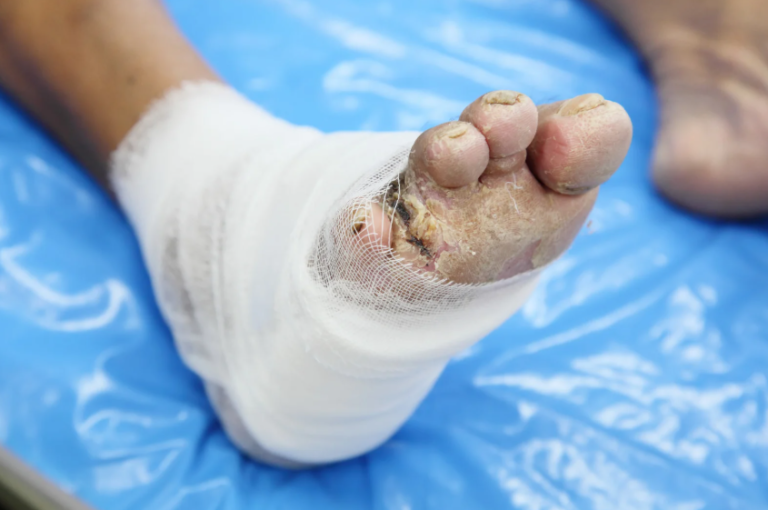Forefoot ulcers are a common but serious condition, especially among individuals with diabetes or other circulatory issues. They can significantly impact a person’s quality of life, causing discomfort, mobility issues, and even leading to complications if not treated effectively. Fortunately, Orthopedic Treatment for Forefoot Ulcers offers promising solutions, providing patients with the chance for faster healing and a more comfortable life. This article will explore how orthopedic care plays a crucial role in healing forefoot ulcers and how seeking the right treatment can help prevent complications.
Forefoot ulcers are open sores that typically develop on the pads of the feet, often at pressure points such as the ball of the foot. These ulcers are most commonly associated with conditions like diabetes, where peripheral neuropathy (nerve damage) and poor circulation increase the risk of skin breakdown. When pressure isn’t alleviated, the skin can break down, leading to the formation of ulcers. Other causes include poor footwear, foot deformities, or trauma.
The significance of Orthopedic Treatment for Forefoot Ulcers cannot be overstated. Without proper treatment, these ulcers can lead to infections, gangrene, and in severe cases, amputation. Early intervention with specialized care is essential to prevent such outcomes and promote efficient healing.
Understanding the Challenges of Healing Forefoot Ulcers
Healing forefoot ulcers presents several challenges, making effective management essential. The forefoot is constantly subjected to pressure during daily activities like walking and standing. For individuals with conditions like diabetes, neuropathy often causes a lack of sensation in the feet, meaning the person may not feel the pressure or pain that could help them address the problem early. Additionally, poor circulation—another common issue in diabetic patients—slows the body’s natural healing processes, making it harder for the ulcer to heal on its own.
The role of Orthopedic Treatment for Forefoot Ulcers is crucial in these situations. By assessing foot structure and pressure points, orthopedic specialists can design targeted treatment plans that address these unique challenges. Proper care can help avoid complications, encourage faster healing, and prevent the recurrence of ulcers in the future.
The Role of Orthopedic Specialists in Forefoot Ulcer Treatment
Orthopedic specialists play a key role in the management of forefoot ulcers, working alongside other healthcare providers, such as podiatrists and wound care nurses, to offer a comprehensive treatment plan. When a patient presents with a forefoot ulcer, an orthopedic specialist typically starts by conducting a thorough assessment of the patient’s foot structure, gait, and any underlying health conditions like diabetes.
Once the assessment is complete, the Orthopedic Treatment for Forefoot Ulcers is customised to meet the patient’s needs. Specialists may recommend a range of treatments, from offloading techniques that relieve pressure on the affected area to surgical procedures that correct deformities or improve circulation. At clinics like Tec Orthopedics, advanced tools and techniques such as pressure mapping and gait analysis are employed to ensure that every treatment plan is as effective as possible.
Orthopedic Treatment Options for Forefoot Ulcers
Offloading Techniques
One of the most effective methods in Orthopedic Treatment for Forefoot Ulcers is offloading, which involves reducing the pressure on the ulcerated area. This can be done using various devices, including total contact casts, removable cast walkers, and specialized shoes. By redistributing weight and relieving pressure from the ulcer, these offloading techniques create an optimal environment for the ulcer to heal.
Total contact casts, for instance, are commonly used in cases of severe ulcers. They completely encase the foot and ankle, distributing pressure evenly and reducing the risk of further injury. Removable cast walkers are often used for more mild cases, as they can be taken off for cleaning and wound care but still provide the necessary protection.
At Tec Orthopedics, specialists provide tailored offloading solutions, ensuring that each patient receives the most suitable option based on their individual needs and the severity of their ulcer.
Custom Orthotics & Insoles
Custom orthotics and insoles are another vital component of Orthopedic Treatment for Forefoot Ulcers. These devices are specifically designed to fit the patient’s foot and relieve pressure on areas susceptible to ulcers. Custom orthotics are crafted to improve the alignment of the foot, distribute weight more evenly, and address any deformities that could exacerbate the condition.
By improving overall foot function, custom orthotics not only promote the healing of forefoot ulcers but also help prevent the recurrence of new ulcers in the future. Tec Orthopedics excels in creating custom orthotics tailored to meet the unique needs of each patient, ensuring optimal comfort and ulcer prevention.
Surgical Interventions
In more severe cases, Orthopedic Treatment for Forefoot Ulcers may involve surgical interventions. For example, surgery may be required to correct deformities like hammertoes or bunions that place constant pressure on the forefoot. Surgical procedures such as tendon lengthening or bone resection can also improve foot function and facilitate the healing process.
Although surgery is generally considered a last resort, it can be highly effective in certain situations, especially when conservative treatments have failed. At Tec Orthopedics, the surgical team is well-equipped to handle such complex cases, offering patients the best possible outcomes through advanced procedures.
Benefits of Orthopedic Treatment for Forefoot Ulcers
The primary benefit of Orthopedic Treatment for Forefoot Ulcers is faster healing. By relieving pressure, improving foot alignment, and addressing underlying issues, orthopedic treatment significantly accelerates the recovery process. Furthermore, these treatments help prevent infections, which can be life-threatening, particularly for diabetic patients.
Orthopedic care also reduces the likelihood of further complications, such as the need for amputation. By improving circulation, correcting deformities, and ensuring proper offloading, patients can often regain full mobility and a better quality of life. The Orthopedic Treatment for Forefoot Ulcers approach prioritises long-term prevention, ensuring that once the ulcer heals, it is less likely to recur in the future.
Success Stories: Real-Life Impact of Orthopedic Care
At Tec Orthopedics, numerous patients have experienced life-changing results from the comprehensive approach to Orthopedic Treatment for Forefoot Ulcers. For example, one patient who had struggled with chronic forefoot ulcers due to diabetes underwent a combination of offloading and custom orthotics. After several months of treatment, the ulcer healed completely, and the patient reported a significant reduction in foot pain and pressure.
Such success stories underscore the importance of seeking professional orthopedic care early. The earlier the intervention, the greater the chance of successful healing and prevention of long-term complications.
How to Choose the Right Orthopedic Care for Forefoot Ulcers
Choosing the right orthopedic care is essential to effective treatment. When selecting a clinic or specialist, it’s important to look for facilities with experience in treating forefoot ulcers and offering a multidisciplinary approach. Make sure they offer comprehensive services such as gait analysis, pressure mapping, custom orthotics, and wound care.
At Tec Orthopedics, the team is trained in using the latest technology to accurately diagnose and treat foot ulcers. With a focus on Orthopedic Treatment for Forefoot Ulcers, Tec Orthopedics provides a holistic and patient-centred approach to care, ensuring the best outcomes for every patient.
Tips for Patients: Supporting Healing at Home
While Orthopedic Treatment for Forefoot Ulcers is essential for healing, there are several steps that patients can take at home to support the process.
- Proper foot hygiene: Keeping the feet clean and dry is crucial to prevent infection.
- Follow-up appointments: Regular check-ups with your orthopedic specialist ensure that the ulcer is healing properly.
- Footwear compliance: Wearing prescribed orthotics or special shoes is key to preventing further damage.
- Lifestyle changes: Eating a balanced diet, managing blood sugar levels, and avoiding smoking can improve circulation and promote healing.
The Power of Orthopedic Treatment for Forefoot Ulcers
Orthopedic Treatment for Forefoot Ulcers is a crucial part of the healing process, offering patients the best chance of recovering from foot ulcers and avoiding complications such as infection or amputation. With treatments like offloading, custom orthotics, and surgical options, orthopedic care can make a significant difference in both the speed and success of healing.
If you or someone you know is struggling with forefoot ulcers, don’t wait—seek professional care. At Tec Orthopedics, the team of experts is ready to provide comprehensive treatment plans tailored to your needs. Contact us today to schedule an assessment and start your journey towards healthier, ulcer-free feet.






